Ronald.phillips
Shared posts
In Redfall, Vampires Are a Metaphor for the Rich and Powerful - CNET
[Steam] (DLC) Gridiron - Gold Package
![[Steam] (DLC) Gridiron - Gold Package [Steam] (DLC) Gridiron - Gold Package](https://external-preview.redd.it/r9VrSwuio5cbkFKohzDi22heVOGRuyJzHVuFiO-q-k4.jpg?width=320&crop=smart&auto=webp&s=0d05c137748ecd965a4fe3fe919c3d3c77e824cc) |
submitted by /u/ColinLab [link] [comments] |
HelloXD Ransomware Installing Backdoor on Targeted Windows and Linux Systems
Elden Ring Patch 1.05 Introduces Changes for New Game Plus, PC-Specific Additions, Performance Improvements and More

A new Elden Ring patch is now live on PC and consoles, bringing some changes for New Game Plus, PC-specific tweaks and additions, performance improvements, and more.
The 1.05 patch New Game Plus changes make it so that select Bell Bearing Items will be available on a new playthrough from the start. Additionally, the patch added emphasis to the choice of the Sacred Flask and several other options that can be improved in the grace menu as well as sound effects when other players' summon signs appear.
Elden Ring Patch 1.05 Additional elements
- In transactions with the NPC "Twin Maiden Husk", the following Bell Bearing items have been changed so that their liberated status will be carried over to the NG+ play.
- Bone Peddler's Bell Bearing/Meat Peddler's Bell Bearing/Medicine Peddler's Bell Bearing/Gravity Stone Peddler's Bell Bearing/Smithing-Stone Miner's Bell Bearing/Somberstone Miner's Bell Bearing/Glovewort Picker's Bell Bearing/Ghost-Glovewort Picker's Bell Bearing
- Added emphasis to the choice of the Sacred Flask and several other options that can be strengthened in the grace menu
- Added sound effects when other players' summon signs appear
The new Elden Ring patch also introduces some PC-specific additions and changes, such as changes for keyboard and mouse controls, a "Return to Desktop" option on the main menu, and more.
Additions and modifications for PC version only
- Added keyboard/mouse operations that can be input in "PRESS ANY BUTTON" on the title screen.
- Added "Return to Desktop" to the system item on the main menu for exiting the game.
- Changed so that mouse click input is not reflected when switching windows to active.
- Fixed a bug that slowed performance when changing "Screen Mode" and "Resolution" in a special procedure.
The Elden Ring 1.05 patch also introduces plenty of bug fixes and performance improvements on all platforms which you can find detailed below.
Bug fixes
- Fixed a bug where equipment could be changed from the equipment menu during the use of a skill under certain circumstances.
- Fixed a bug in the "War Cry" skill where the effect was applied to a weapon that was not the target of the skill.
- Fixed a bug where some actions of the "Barbaric Roar", "War Cry", and "Troll's Roar" recovery time was longer than expected.
- Fixed a bug where the effects of the "Determination" and "Royal Knight's Resolve" skill does not always wear off with certain weapons.
- Fixed a bug in which some attacks of the "Ice Spear" skill are unguardable.
- Fixed a bug that caused the attack power of some skills to be reduced when using the "Golden Vow" skill.
- Fixed a bug that the light wave of the "Moonlight Greatsword" skill sometimes does not aim at the locked-on target.
- Fixed a bug that caused damage to allies when using the "Seppuku" skill under certain circumstances.
- Fixed a bug that caused the increase in attack power of the "Seppuku" skill to be higher than expected for some attack motions.
- Fixed a bug in which a status effect was applied when using the "Hoarah Loux's Earthshaker" skill.
- Fixed a bug where the "Waves of Darkness" skill would not hit the enemy with a spinning cleave.
- Fixed a bug that caused unintended motions to be played when switching to a different sorceries or incantations while using a sorcery or incantation.
- Fixed a bug that the FP consumption increased when using the sorceries "Magma Shot" and "Roiling Magma" while riding a horse.
- Fixed a bug where the “Claw Talisman” effect was not applied when jumping with the "Starscourge Greatsword" in both hands.
- Fixed a bug that the power of two-handed attacks except jump attack of the weapon "Golem's Halberd " is different from expected.
- Fixed a bug that when using the weapon "Pulley Crossbow" with the left hand while the right hand weapon was given an attribute by magic or item, the effect was given to the "Pulley Crossbow" as well.
- Fixed a bug in which arrows and bolts that did not match the type of long-range weapon could be released in certain procedures.
- Fixed a bug in which guard boost was reduced when some weapons were strengthened to the maximum.
- Fixed a bug in which the attributes of weapons could be changed while the inventory had reached its maximum capacity and the ashes of war could not be changed.
- Fixed a bug that caused the boss "Malenia, Goddess of Rot" to have low HP under certain circumstances.
- Fixed a bug that allowed enemies to be attacked from outside the fog in certain areas.
- Fixed a bug in online multiplayer where, when a boss is defeated in the host's world as a cooperative player, the same boss may not appear in your world.
- Fixed a bug that prevented the battle with the boss "God-Devouring Serpent" from progressing under certain circumstances.
- Fixed a bug that prevented hostile NPCs from appearing under certain circumstances.
- Fixed a bug that prevented the event of the NPC "Alexander, Warrior Jar" from progressing under certain circumstances.
- Fixed an issue where the item "Sacred Flask" is not restored after destroying a group of enemies under certain circumstances.
- Fixed a bug that under certain circumstances, after defeating the boss "Starscourge Radahn", the user could not move from the map to the grace.
*If you cannot move from the map to the grace, you can move to the grace by touching the grace "Starscourge Radahn”.
- Fixed a bug that prevented found sites of grace from registering on the map under certain circumstances.
- Fixed a bug that prevented some graces from being able to be touched when approached under certain circumstances.
- Fixed a bug that allowed hostile guests to enter boss areas under certain circumstances.
- Fixed a bug that prevented a critical hit from behind from hitting in hostile multiplayer.
- Fixed a bug that caused performance to slow down when the "Sentry's Torch" weapon was equipped under certain circumstances.
- Improved stability of online multiplayer between PS4 and PS5
- Improved loading times for the Xbox Series X|S version
- Fixed a bug that the master volume setting was not reflected in some cutscenes
- Improved stability of online multiplayer.
- Fixed a bug that caused sounds to play differently than expected in some situations.
- Fixed a bug that caused the player to become inoperable and die in certain locations.
- Fixed a bug in which the drawing and hit detection were different than expected in some maps.
- Fixed a bug in some maps that allowed players to reach unexpected locations with certain procedures.
- Fixed some texts.
- Several other performance improvements and bug fixes
Elden Ring is now available on PC, PlayStation 5, PlayStation 4, Xbox Series X, Xbox Series S and Xbox One worldwide.
The post Elden Ring Patch 1.05 Introduces Changes for New Game Plus, PC-Specific Additions, Performance Improvements and More by Francesco De Meo appeared first on Wccftech.
Fallout Update 1.3b

This patch builds on TeamX's 1.3.5 update, adding sfall and a couple of other fixes.
Two Tech CEOs Wanted Every Worker to Have a Permanent, Publicly-Available Job Performance File
Read more of this story at Slashdot.
Every new trailer from the Xbox & Bethesda Games Showcase 2022

The Xbox & Bethesda Games Showcase for 2022 has now wrapped, bringing plenty of trailers and announcements for upcoming games on Xbox and PC. The rule for this showcase, as outlined early on, is that every game shown will launch within the next 12 months. What the future will actually hold remains to be seen, but Xbox certainly sound optimistic at least. With Starfield, Hollow Knight: Silksong, Diablo IV, and much more shown at the event, there’s plenty to cover. Let's get started then, shall we? Here's a reminder of every announcement and trailer from the Xbox & Bethesda Games Showcase 2022.
Finally, another look at System Shock, with Warren Spector, no less

Still no release date
Nightdive Studios' System Shock remake was shown today at the PC Gaming Show, with a surprise appearance from classic game designer Warren Spector. He mused on how primitive the old UI was for the original, and the "unfortunate" nature of the modern era not really seeing the influence of System Shock.
He also told PC Gamer the following:
"I think of myself, as much as anything, as a relentless advocate for a particular kind of game, the genre we call immersive simulation. Games that are designed to let the player feel—basically force the player to feel—like it's them in the world, with as few distractions and 'game-y' things as possible. System Shock was really, at the time, the most advanced version of that, and I can't tell you how much the team is responsible for that."
It's still due out on PC, PS4/PS5, Xbox One/Xbox Series X. Keeping in time with every reveal so far, there is no release date in sight for it! If we eventually get a release date, or even a real window for this thing, it just wouldn't be a System Shock remake trailer.
PC Gaming Show System Shock trailer and brief talk with Warren Spector:
https://www.youtube.com/watch?v=06lOzXU1F_M
Just the trailer:
https://www.youtube.com/watch?v=n2b1zQkYsyM
The post Finally, another look at System Shock, with Warren Spector, no less appeared first on Destructoid.
Ambitious Half-Life: Alyx mod Leviathan brings a whole new adventure

A new adventure from some of the community's best modders
Valve's catalog has been modded again and again, and has even given birth to iconic titles like Garry's Mod and The Stanley Parable. Now the modding community is taking on the studio's most recent release, Half-Life: Alyx, to build on the game's world and characters and deliver a whole new narrative adventure. It's called Half-Life Alyx: Leviathan, and we got a full eight-minute gameplay demo during today's PC Gaming Show.
https://www.youtube.com/watch?v=4WE1qf3Z_-s
We got a look at some close encounters, tense shootouts, and even a brief cameo by the ever-iconic Gordon Freeman. Leviathan looks indistinguishable from the real Half-Life: Alyx experience, and it looks like it's shaping up to be a must-play for anyone with a VR headset.
The project was created by modders FMPONE and Corey Laddo, and is set to release sometime in 2022 on Steam.
The post Ambitious Half-Life: Alyx mod Leviathan brings a whole new adventure appeared first on Destructoid.
Cybersecurity Products Rarely Live Up To Marketing Claims: RSA Panel
Read more of this story at Slashdot.
Recap: Everything that happened at the Microsoft and Bethesda “E3” 2022 showcase

It was basically all games, which was nice
So that wasn't bad! No weird ads from The Rock peddling energy drinks and comic book movies. No awkward or cringeworthy skits. Just an hour and a half-ish of pure games: here's a Microsoft and Bethesda recap for the 2022 "E3" showcase stream.
We began with a new look at Redfall, which gave us an endearing showing of gameplay: noting its stark differences to other similar squad-based shooters. From there it shot into Hollow Knight: Silksong, and although we didn't get any concrete info on the release date, we know that it exists! I'm glad someone finally showed that thing at some stream in any form (how many Nintendo Directs was it rumored to be at? All of them?).
Those two kind of defined the Microsoft and Bethesda 2022 Games Showcase as a whole. We got some big AAA reveals and gameplay and a focus on indie games. I have to admit, it was weird to see Overwatch 2 and Diablo IV in there presented as "Microsoft" titles, but that's just how things will be going forward. It's wild to think about, if Microsoft can turn the company's reputation around, what a future Microsoft "E3" showcase might look like.
The "one more thing" was actual Starfield gameplay, which I was beginning to think we'd never see. It looks...fine! Some people will think it looks more than fine, and others will want to see more before making a firm decision: such is the life of a Bethesda Studios game in 2022 after some tumultuous launches.
The biggest reveal was arguably Persona coming to Xbox. The total proliferation of that series is something that needed to happen as quickly as possible! And that "everything today is focused on games you can play over the next 12 months" quote from the stream was reassuring. Good one, Microsoft!
https://www.youtube.com/watch?v=rOYnwhKwlw8
A 2022 "E3" stream Microsoft and Bethesda recap:
- We got another look at the vampire shooter Redfall at the Xbox conference
- Hollow Knight: Silksong will be on Game Pass day one
- Get High on Life Squanch Games’ super-gooey alien shooter
- Riot Games is coming to Game Pass with a ton of unlocks
- Forza Motorsport is still looking fantastic, two years on, out in spring 2023
- A Plague Tale: Requiem gets a chilling new trailer
- Microsoft Flight Simulator has a free Halo crossover out today
- Overwatch 2 enters early access as a free-to-play title October 4
- Microsoft teases Ark 2 for 2023
- Ara: History Untold is a new historical grand strategy game from Oxide Games
- Forza 5 gets its own Hot Wheels crossover expansion
- Scorn will be out just in time for Halloween
- Barbaric magic and wild adventure combine in Flintlock: The Siege of Dawn
- Gunfire Reborn is coming to Xbox in October 2022
- Lightyear Frontier is a delightful space-themed farming sim
- Minecraft Legends heroically quests forth in 2023
- The Last Case of Benedict Fox is a cosmic horror metroidvania for PC and Xbox
- As Dusk Falls is described as an emotional, psychological drama of choice and consequence
- Grounded is FINALLY coming out of early access in September
- Pentiment is a medieval narrative adventure coming from Obsidian
- Naraka: Bladepoint comes to Xbox Series consoles on June 23
- The dead will walk with The Necromancer in Diablo IV, coming 2023
- Mystical stealth game Ereban: Shadow Legacy will be on Game Pass day one
- Whoa, Team Ninja’s Wo Long: Fallen Dynasty looks rad
- Cocoon is a colorful puzzle game from the designer of Inside and Limbo
- Ravenlok is a new adventure from the makers of Echo Generation, arriving in 2023
- Oh hell yeah, Persona 3, 4, 5 are headed to Xbox
- Hideo Kojima pops his head in to say ‘Yeah, I’m making something for Xbox’
- Starfield looks absolutely out of this world in new gameplay deep-dive
The post Recap: Everything that happened at the Microsoft and Bethesda “E3” 2022 showcase appeared first on Destructoid.
Starfield Shows First Open-World and Combat Footage, Game Offers 1000 Explorable Planets

Starfield is one of the most hotly-anticipated games coming out in the next year, and certainly the exciting Xbox exclusive on the near horizon, and yet, we’ve seen very little of the project. A teaser trailer and some concept art has really been it. Well, today at the Xbox & Bethesda Games Showcase, the curtain was finally pulled back on Starfield, with over 10 minutes of actual gameplay being shown.
We get a look at planetary exploration on the rocky moon of Kreet, including scanning, resource collecting, and more. We also get a look at some of the game’s colonies, including the Constellation headquarters of New Atlantis. Overall, Bethesda is promising over 1000 full explorable planets. Of course, customization will be a big part of the package, with players being able to create and customize their own characters, outposts, and yes, even spaceships. Perhaps most surprising, is the action, which is surprisingly intense looking. Starfield is more than just some laid back riff on Star Trek. But hey, enough of my preamble, check out the new Starfield footage for yourself, below.
It really looks like Bethesda is really going the extra step to make the most full-fledged sci-fi RPG possible. I’m ready to take off to the stars! Here's Bethesda's official description for Starfield:
The year is 2330. Humanity has ventured beyond our solar system, settling new planets, and living as a spacefaring people. From humble beginnings as a space miner, you will join Constellation — the last group of space explorers seeking rare artifacts throughout the galaxy — and navigate the vast expanse of the Settled Systems in Bethesda Game Studios’ biggest and most ambitious game. In this next generation role-playing game set amongst the stars, you will create any character you want and explore with unparalleled freedom as you embark on an epic journey to answer humanity’s greatest question: What is out there?
Starfield launches on PC and Xbox Series X/S in the first half of 2023.
The post Starfield Shows First Open-World and Combat Footage, Game Offers 1000 Explorable Planets by Nathan Birch appeared first on Wccftech.
Get ARK: Survival Evolved for FREE on Steam
Starting from today until June 19th at 7:00 PM CET you can grab the open world survival game ARK: Survival Evolved for free on Steam!
The post Get ARK: Survival Evolved for FREE on Steam appeared first on Indie Game Bundles.
AMD’s Senior Graphics R&D Engineer is working on a Path Tracing Mod for Return to Castle Wolfenstein
AMD’s Senior Graphics R&D Engineer, Dihara Wijetunga, is currently working on a Path Tracing Mod for Return to Castle Wolfenstein. Similarly to Quake 2 RTX, Doom Path Tracing and Serious Sam Path Tracing, this mod will introduce full real-time path tracing effects to the game. According to the developer, this mod is still in an … Continue reading AMD’s Senior Graphics R&D Engineer is working on a Path Tracing Mod for Return to Castle Wolfenstein →
The post AMD’s Senior Graphics R&D Engineer is working on a Path Tracing Mod for Return to Castle Wolfenstein appeared first on DSOGaming.
Virtualizing Linux, macOS, and Windows ARM64 versions on an M1 Mac
[Steam](Game) Trials of the Iluminati Sea Creatures
Cybersecurity Courses Ramp Up Amid Shortage of Professionals
The pressure was on. Someone, somewhere, was attacking computer systems so customers couldn’t reach certain websites. In a windowless room in Denver, Zack Privette had worked all morning with his security team to figure out what the cyber strangers were up to.
Starlink Ready To Turn On Laser Satellites For Internet Coverage

Space Exploration Technologies Corporation's (SpaceX) Starlink satellite internet service is gearing up to activate its first batch of new satellites. Starlink is currently providing users with Internet coverage all over the globe through its network of small satellites, ground stations and user terminals. In order to diversify coverage, improve speeds and reduce costly infrastructure costs, Starlink has also deployed newer satellites that feature optical links, dubbed lasers. These will allow the spacecraft to transfer data within themselves and increase the range at which the network can operate without having to rely on the ground stations.
On this front, Starlink has submitted an application to the Federal Communications Commission (FCC) seeking authority to activate spacecraft in polar orbits.
Starlink Assures FCC It Will Cooperate With OneWeb and Kepler In Polar Orbit Operations
The application was filed in the FCC's International Bureau's filing system in mid-June and the Commission accepted it for filing purposes earlier this month. It seeks the regulatory body's approval to temporarily operate Starlink satellites at latitudes higher than 53 degrees, which constitute remote regions of the Earth where Internet connectivity is hard to come by.
Starlink uses its satellites to transfer data between users with dishes to its ground stations. The ground stations then carry the data to the internet servers, after which they beam it back up to the spacecraft to complete the cycle SpaceX has built dozens of these stations all over the U.S., but placing them in the remote polar regions is harder than installing them in CONUS.
For these purposes, the company has focused on launching satellites with inter-optical connectivity, or lasers, to serve the polar regions. This was confirmed by SpaceX chief Mr. Elon Musk early last year, when he outlined that all satellites going up this year will feature lasers, and that his company had limited itself to launching the spacecraft back then only to polar regions.

In its application, Starlink explains to the FCC that the request is only temporary in nature as through it it will operate the satellites at a 10 degree elevation. Starlink is currently authorized to operate its satellites at a higher 25 degree elevation, and it outlined that the lower angles are a "stop gap" measure before the constellation is capable of providing service at 25 degrees. Lower angles allow for lesser spacecraft being able to communicate with the user terminals but also result in poor communication due to longer distances and terrain characteristics.
According to Starlink:
This application requests carefully limited, temporary authority solely to authorize communications between SpaceX satellites and user terminals at elevation angles no less than 10 degrees in polar regions — i.e., at latitudes above 53 degrees. This application does not seek authority to deploy any additional satellites or earth stations. It also does not seek any change in the technical or operating characteristics of the satellites and earth stations the Commission has already authorized, except for this narrow change to the minimum elevation angle observed in polar regions. This stop-gap operation will enable SpaceX to speed deployment of its high-speed, low-latency service to the polar regions of the United States in the interim period before SpaceX’s system is sufficiently deployed to provide polar service at its already authorized 25-degree minimum elevation angle.
Because of the lower angles, SpaceX also addresses concerns that its rivals might have. It assures the Commission that the 10 degree elevation will result in lesser interference with OneWeb's satellites since they operate at 45 degrees or higher. Additionally, it also intends to with Kepler based on data shared.
Starlink has recently opened up its service to mobile users in recreational vehicles, and as it struggles with excessive demand in some areas, the service has also started to warn users of low speeds during peak times.
The post Starlink Ready To Turn On Laser Satellites For Internet Coverage by Ramish Zafar appeared first on Wccftech.
The Big Difference Between Hughie's Powers In The Boys Show And Comic Explained
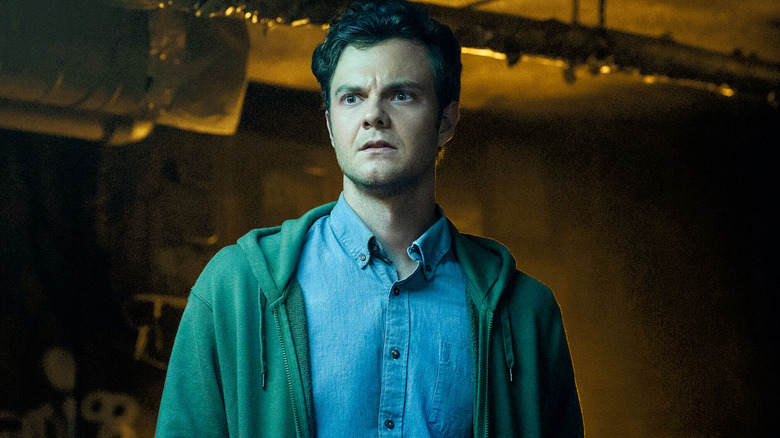
This article contains spoilers through episode 4 of "The Boys" season 3.
Hughie Campbell (Jack Quaid) never wanted to be part of a superhero-killing crusade, but sometimes life just happens. And after the first time you find yourself thoroughly traumatized and covered in whale guts, taking control of your life becomes a big priority — which is exactly why Hughie was so thrilled to take a job at the Federal Bureau of Superhuman Affairs, where he could spend the season filing papers and busting supes with the law, instead of using butt-bombs.
Unfortunately, Hughie exists in the cruel and nasty world of "The Boys," where such ease is only temporary. By the time "Glorious Five Year Plan" comes along (the fourth episode of the third season), Hughie's suit and tie days are behind him and he's officially back in the chaos of Butcher's reckless crusade to take out supes by any means necessary. As it turns out, this means becoming supes themselves.
Thanks to the newly acquired Compound V-24 (aka Temp V), any idiot willing to inject themselves with the experimental drug can get superhuman abilities for 24 hours, which helps the Boys level the playing field a little. While Frenchie and MM charge into battle wielding guns, Butcher and Hughie are secretly wielding the power of V: during the fight to find the weapon that "killed" Soldier Boy, the duo unleash their powers in front of the team. While it definitely takes their fellow Boys by surprise, fans of the comics have seen this coming for a while. Hughie's powers are actually a big part of his character from the get-go, but with the Prime Video adaptation, there comes a couple of big changes.
Hughie's Supe Era: The Comics Vs The Show
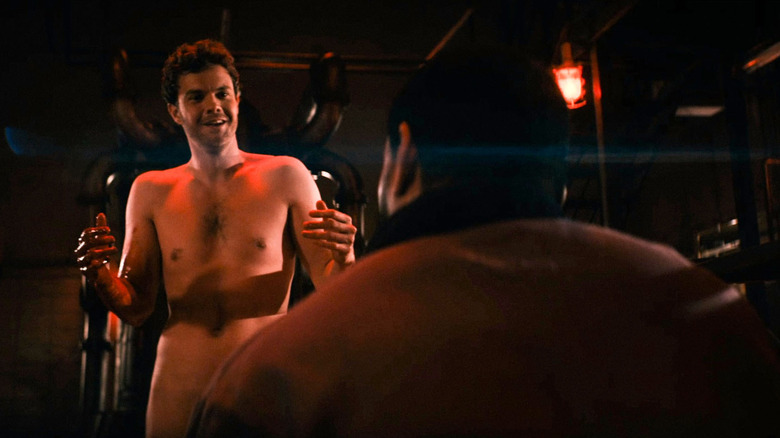
First off, the actual power Hughie possesses is a little different than comic readers will remember, but superhuman strength and durability carry over in both iterations. After being injected with Temp V, Hughie becomes strong enough to punch a hole in a man's chest. In the show, the unlucky victim is a lab guard in the Russian-controlled facility that hides Soldier Boy, whereas in the comics Hughie takes down an actual supe with his punch — Teenage Kix member Blarney Cock.
Other than whose abdomen he puts his arm through, what else is different about Hughie's power? In the show, he also has the ability to teleport. Hughie can now disappear from one place and appear in another, with the minor caveat of losing his clothes in the process. The irony of this bonus power is hilarious — before being sucked into Butcher's orbit, Hughie's first instinct has always been to run away from danger. Now he has a power that lets him either dart the hell out of a bad situation or leap into battle.
There's also another layer of intrigue: Hughie's power resembles A-Train's, the very supe who put him on this path in the first place by killing his girlfriend. Similarly, Butcher's tangle with the V gives him laser eyes that are a lot like Homelander's, making him a mirror of the supe who ruined and continuously haunts his life. It's almost like there's a lesson to be learned about not becoming the thing you hate. Mother's Milk even tries to point this out to them ("the whole point of what we do is that no one should have that kind of power"), but it might be a while before Hughie and Butcher hear logic.
The Origin Of Hughie's Power
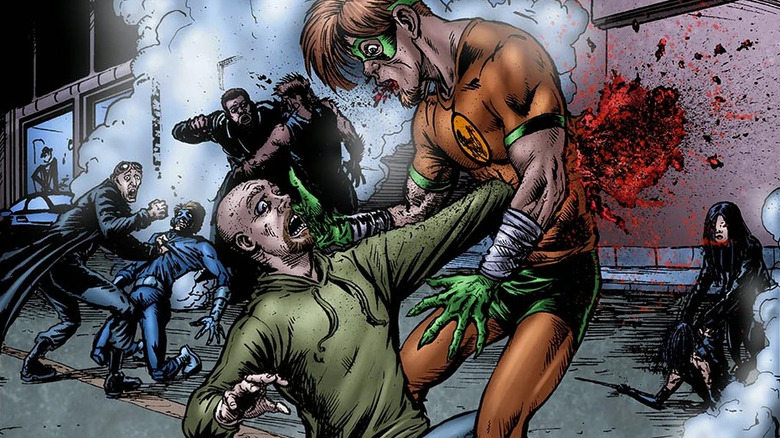
The most interesting difference between Hughie's powers in the comics vs. the show is the circumstances of the V injection. In the comics, Butcher forces the drug on him, catching Hughie by surprise and injecting him on their first mission. The results are permanent and Hughie is upset — partially because he had a needle jammed into his neck without permission, but even more so when he discovers why. Initially, his powers are difficult to control and when he kills Blarney with a punch, it's very upsetting. But this isn't quite the case for Prime Video's iteration of Hughie.
While punching through the Russian certainly catches Hughie off-guard (he follows it up with a reflexive "sorry!"), he isn't very torn up about it. When he pushes the corpse to the ground and examines his blood-soaked arm, Hughie is ecstatic to discover his power. It's a little troubling that he gets over the accidental death so quickly, but in all fairness, show Hughie has been at this for quite some time. In the comics this superpowered kill was his first, but onscreen Hughie has seen much worse. In the show, taking the V is Hughie's own choice. It helps that the effects are only temporary, but all things considered he is still thrilled to have powers. After a season spent worrying about his ability to protect Starlight and feeling inadequate in the presence of supes, he now has a fighting chance.
Is Hughie Heading Down A Dark Path?
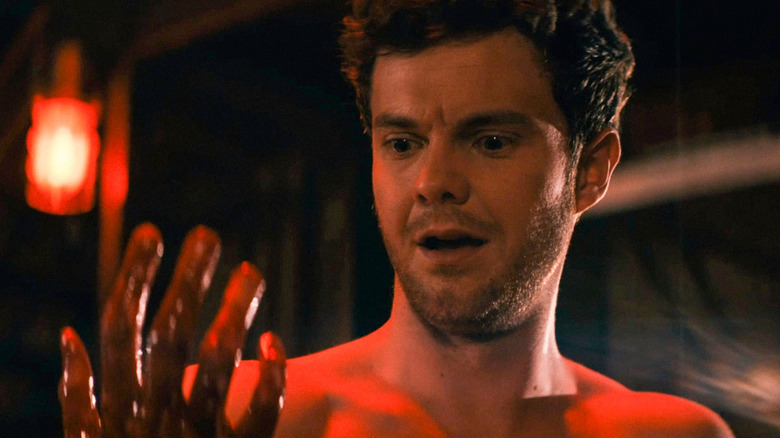
In the comic world, Hughie punching through Blarney also signals another change in his character: he's horrified by his strength and resents Butcher for thrusting power on him. This sparks tension between the two that slowly intensifies. In the show, Butcher and Hughie are heading down a dark path together, both embracing the effects of the Temp V despite their comrades disapproving. Frenchie and MM are horrified, while Kimiko takes it personally: why would they do this to themselves willingly? She's hated her powers every day of her life. Odds are Starlight won't be a fan either, so if Hughie keeps it up, there's no telling how it might alter the relationships in his life.
When Hughie first discovered what Butcher was up to, he was warned: "It's not power. It's punishment." But Hughie has another perspective: having power is intoxicating, especially when you have the face and general demeanor of a kicked puppy. But if the V and the allure of power eclipse Hughie's better judgment, it won't be long before he loses his status as the team's "canary" and becomes just another Butcher that needs to be reigned in.
The first four episodes of "The Boys" season 3 are currently streaming on Prime Video, with new episodes coming every Friday.
Read this next: Joker's Wild: Ranking The Cinematic Versions Of The Clown Prince Of Crime
The post The Big Difference Between Hughie's Powers in The Boys Show and Comic Explained appeared first on /Film.
Symbiote: A New, Nearly-Impossible-to-Detect Linux Threat
Read more of this story at Slashdot.
GPU-accelerated video decoding
Picking up where I left off last time, I’d like to discuss a few more things when using video decoding libraries in your own graphics pipeline. Actually, the previous article was just meant as the introduction to the more technical implementation details, but I got carried away.
Video decoding… it’s a thing. A solved thing, if you just want your basic “I have a video and a window, and I want to display the video in the window”. There are various libraries that can do that for you (DirectShow, Media Foundation, VLC, FFmpeg etc), and generally they will use the GPU to accelerate the decoding. Which is pretty much a requirement for more high-end content, such as 4k 60 fps video.
But I want to talk about just how thin of a line that GPU-accelerated decoding is. Because as soon as you want to do anything other than just displaying the video content in a window managed by the library, you run into limitations. If you want to do anything with the video frames, you usually just want to get a pointer to the pixel data of the frame in some way.
And that is where things tend to fall apart. Such a pointer will have to be in system memory. Worst case (which used to be quite often) this will trigger a chain reaction of the library doing everything in system memory in that case, which means it will also use the CPU to decode, rather than the GPU. See, as long as the library can manage the entire decoding chain from start to finish, and has freedom to decide which buffers to allocate where, and how to output the data, things are fine. But as soon as you want to have access to these buffers in some way, it may falls apart.
In the average case, it may use GPU acceleration for the actual decoding, but then copy the internal GPU buffer to a system buffer. And then you will have to copy it BACK to the GPU in your own texture, to do some actual rendering with it. The higher the resolution and framerate, the more annoying this GPU<->CPU traffic is, because it takes up a lot of precious CPU time and bandwidth.
But there’s a tiny bit more to it…
RGB32 vs NV12 format
In the modern world of truecolour graphics, we tend to use RGB pixelformats for textures, the most common being 8 bits per pixel, packed into a 32-bit word. The remaining 8-bits may be left undefined, or used as an extra alpha (A) component. The exact order may differ between different hardware/software, so we can have RGBA, BGRA, ARGB and whatnot, but let’s call this class ‘RGB32’, as in: “some variation of RGB, stored in a 32-bit word”. That is the variation you will generally want to use when rendering with textures.
For video however, this is not ideal. YUV colour models were used by JPEG and MPEG, among other formats, because they have interesting properties for compression. A YUV (again an umbrella term for various different, but related pixel formats) colour model takes human perception into consideration. It decomposes a colour into luminance (brightness) and chrominance (colour) values. The human eye is more sensitive to luminance than to chrominance, which means that you can store the chrominance values with a lower resolution than the luminance values, without having much of an effect on the perceived visual quality.
In fact, getting back to the old analog PAL and NTSC formats: These formats were originally black-and-white, so they contained only the luminance of the signal. When colour information (chrominance) was added later, it was added at a lower resolution than the luminance. PAL actually uses YUV, and NTSC uses the similar YIQ encoding. The lower resolution of the chroma signal leads to the phenomenon of artifacting, which was exploited on CGA in 8088 MPH.
In the digital world, the Y (luminance) component is stored at the full resolution, and the U and V (chrominance) components are stored at a reduced resolution. A common format is 4:2:0, which means that for every 4 Y samples, 1 U sample and 1 V sample is stored. In other words, for every 2×2 block of pixels, all Y-values are stored, and only the average U and V values of the block are stored.
When converting back to RGB, the U and V components can be scaled back up, usually with a bilinear filter or such. This can easily be implemented in hardware, so that the pixel data can be stored in the more compact YUV layout, reducing the required memory footprint and bandwidth when decoding video frames. With RGB32, you need 32 bits per pixel. With an YUV 4:2:0 format, for 4 pixels you need to store a total of 6 samples, so 6*8 = 48 bits. That is effectively 48/4 = 12 bits per pixel, so only 37.5% of RGB32. That matters.
When you want to get access to the frame data yourself, you generally have to tell the decoder which format to decode to. This is another pitfall where things may fall apart, performance-wise. That is, a lot of hardware-accelerated decoders will decode into a YUV-layout. If you specify that you want to decode the frame into an RGB32 format, this may cause the decoder to choose a decoding path that is partially or even entirely run on the CPU, and as such will perform considerably worse.
In practice, the most common format that accelerated decoders will decode to is NV12. For an overview of NV12 and various other pixel formats, see this MSDN page. In short, NV12 is a format that stores YUV data in a single buffer, with the Y component first, and then the U and V components packed together:

This format is supported in hardware on a wide range of devices, and is your best bet for efficient accelerated GPU decoding.
What’s more: this format is also supported as a texture format, so for example with Direct3D11, you can use NV12 textures directly inside a shader. The translation from YUV to RGB is not done automatically for you though, but can be done inside the shader.
The format is a bit quirky. As it is a single buffer, that contains two sets of data, at different resolutions, Direct3D11 solves this by allowing you to create two shader views on the texture. For the Y component, you create an ID3D11ShaderResourceView with the DXGI_FORMAT_R8_UNORM format. For the U and V components, you create an ID3D11ShaderResourceView with the DXGI_FORMAT_R8G8_UNORM format. You can then bind these views as two separate textures to the pipeline, and read the Y component from the R component of the R8_UNORM view, and the U and V components from the R and G components of the R8G8_UNORM view respectively. From there you can do the usual conversion to RGB.
So the ideal way to decode video is to have the hardware routine decode it to NV12, and then let you have access to the NV12 buffer.
Using Media Foundation
With Media Foundation, it is possible to share your Direct3D11 device between your application and the Media Foundation accelerated decoders. This can be done via the IMFDXGIDeviceManager, which you can create with the MFCreateDXGIDeviceManager function. You can then use IMFDXGIDeviceManager::ResetDevice() to connect your D3D11 device to MediaFoundation. Important is to set your device to multithread-protected via the ID3D10Manager interface first.
This IMFDXGIDeviceManager can then be connected for example to your IMFSourceReader by setting its MF_SOURCE_READER_D3D_MANAGER attribute. As a result, any GPU acceleration done through D3D11 will now be done with your device, and as such, the resources created will belong to your device, and as such can be accessed directly.
A quick-and-dirty way to get to the underlying DXGI buffers is to query the IMFMediaBuffer of a video sample for its IMFDXGIBuffer interface. This interface allows you to get to the underlying ID3D11Texture2D via its GetResource method. And there you are. You have access to the actual D3D11 texture that was used by the GPU-accelerated decoder.
You probably still need to make a copy of this texture to your own texture with the same format, because you need to have a texture that has the D3D11_BIND_SHADER_RESOURCE flag set, if you want to use it in a shader, and the decoder usually does not set that flag. But since it is all done on the GPU, this is reasonably efficient.
Timing on external clock
Another non-standard use of video decoding frameworks is to take matters in your own hand, and output the audio and video frames synchronized to an external clock. By default, the decoder framework will just output the frames in realtime, based on whatever clock source it uses internally. But if you want to output it to a device with an external clock, you need to sync the frames yourself.
With DirectShow and MediaFoundation, this is not that difficult: every audio and video sample that is decoded, is provided with a timestamp, with an accuracy of 100 ns. So you can simply buffer a number of samples, and send them out based on their timestamp, relative to the reference clock of your choice.
For some reason, LibVLC only provides timestamps with the audio samples, not with the video samples it decodes. So that makes it difficult to use LibVLC in this way. Initially it did not have an easy way to decode frames on-demand at all, but recently they added a libvlc_media_player_next_frame() function to skip to the next frame manually. Then it is up to you to figure out what the frame time should be exactly.
One issue here though, is that if you let the library decode the video in realtime, it will also automatically compensate for any performance problems. So it will automatically apply frame skipping when required. If you are decoding manually, at your own speed, then you will need to manually take care of a situation where you may not be able to keep your decode buffer full, when the decoder cannot keep up. You may need to manually skip the playback position in the decoder ahead to keep in sync with the video output speed.
All in all, things aren’t always that straightforward when you don’t just let the video library decode the video by itself, and letting it time and display the output itself.
Elden Ring mod explains exactly how every item effect works
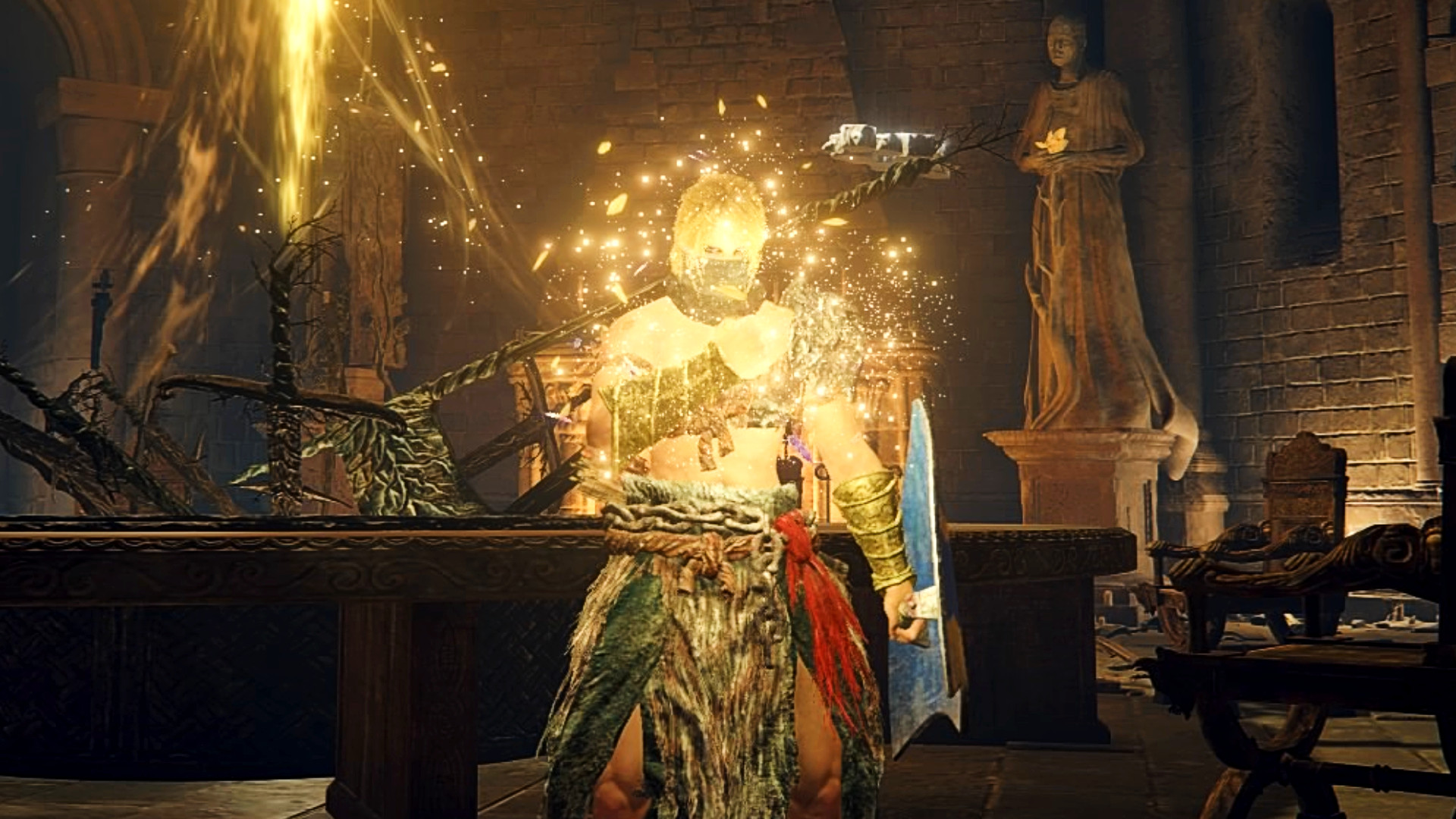
If you’ve ever picked up an item in FromSoftware’s expansive open-world game and been confused about how it works, an Elden Ring mod has got you covered. The Detailed Item Descriptions mod does exactly what it says on the tin - adding new, extensive item descriptions complete with exact damage numbers and percentages for every single item in the RPG game. This includes spells, equipment, and weapon skills along with all of the usable items.
Dziggy, creator of the Detailed Item Descriptions Elden Ring mod, says they made the mod because they were “sick of looking up every item to see what it actually did.” As a result, they embarked on a mammoth undertaking to rewrite the descriptions for “every single item in the game, including spells, equipment, and weapon skills.” These descriptions now include accurate, often detailed text descriptions that explain how the item is used and what effects it can apply.
The mod also details exact numbers, breaking them down into individual statistics such as base physical damage, stat accumulation (for buildup effects such as sleep or bleed), and buff or debuff percentages applied to affected characters. It even uses coloured text to break things up nicely into an easily readable and understandable format.
RELATED LINKS: The best Elden Ring builds, Elden Ring bosses, The best Elden Ring classesAre Unfriendly AI the Biggest Risk to Humanity?
Read more of this story at Slashdot.
Can’t wait for Wolfenstein 3? RTCW is getting ray tracing
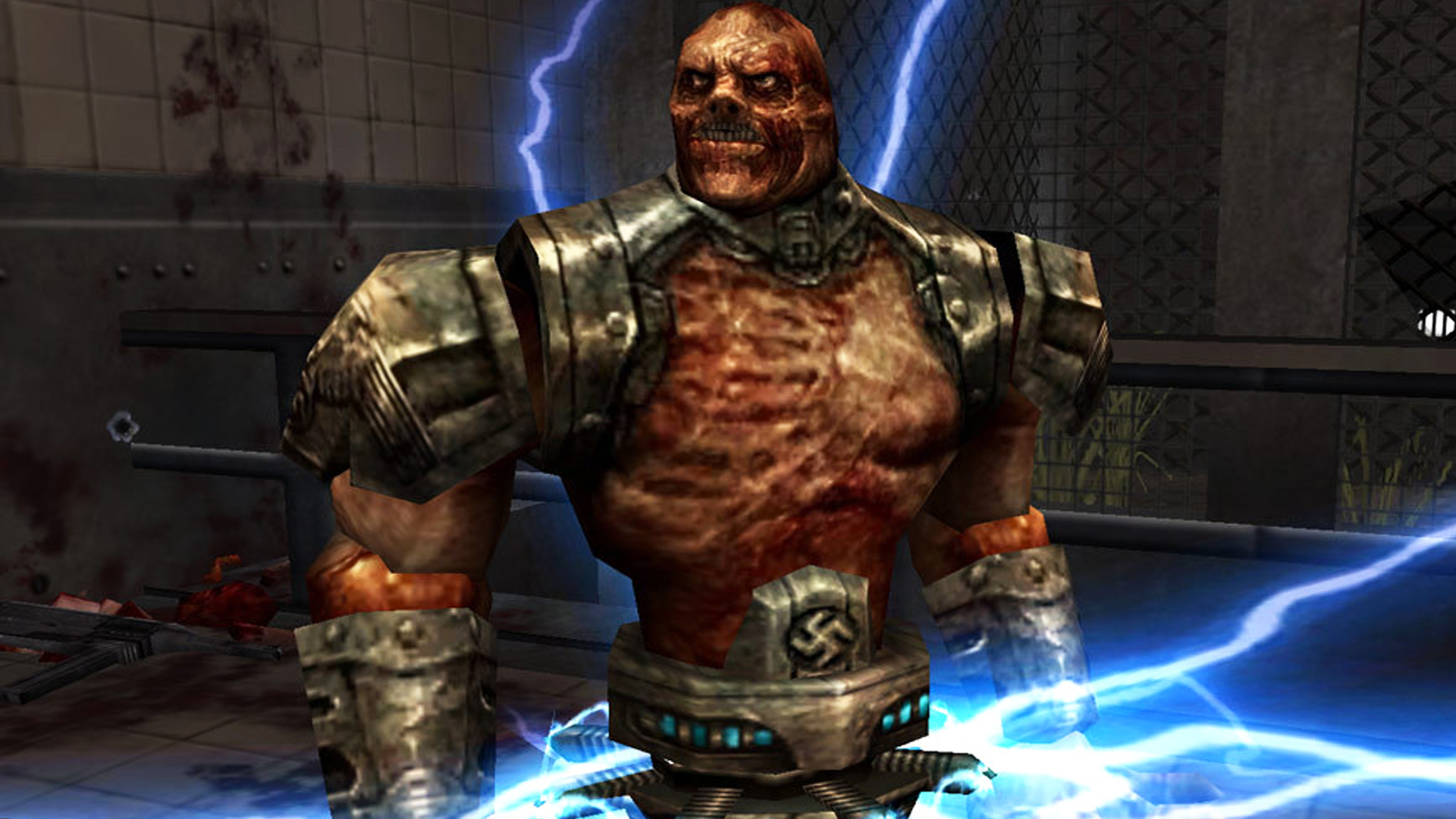
The Xbox Bethesda showcase is sure to bring some Starfield news please, but many fans (including us) are hoping to finally get a Wolfenstein 3 reveal. Even if it does, it'll likely still be a long way off, but what might ease the wait is a Return to Castle Wolfenstein ray tracing mod.
The newer Wolfenstein games by Machine Games are fantastic but there's something really special about 2001's Return to Castle Wolfenstein. It's had plenty of mods in its time - including a recent effort to recreate the lost Enemy Territory single-player expansion - but it's still looking a bit long in the tooth at this point, despite the overhaul mod released a few years ago.
Well, if Doom can get ray tracing, so can the best Wolfenstein game - and this isn't coming from a regular fan, either. Dihara Wijetunga is a senior graphics research and development engineer at AMD and they're creating a Wolf PT mod - no, not that PT, this is a "real-time path tracer" mod with "a custom DX12 backend."
'Lord of the Rings: Rings of Power' Opens With 'Shadow of the Past' - CNET
The 15 Best Ghost Movies Of All Time, Ranked
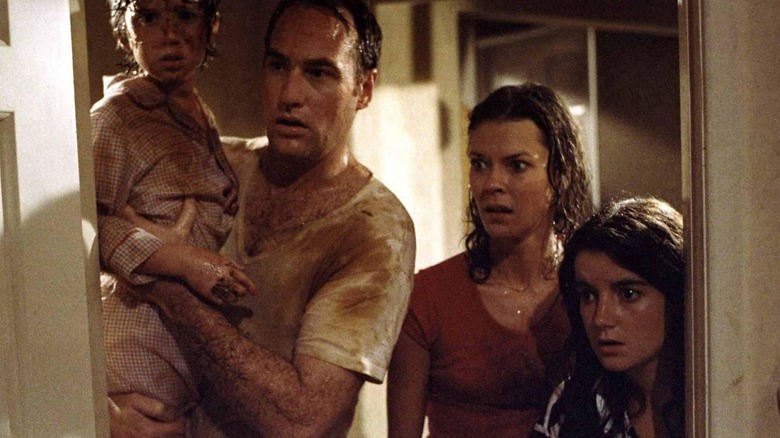
Specters and poltergeists and ghosts, oh my!
Haunted houses litter the horror landscape, but some are eerier than others. From family-friendly features to truly terrifying tales, ghost stories can span a wide range of themes and play out in a million different ways to varying degrees of success. So what makes a ghost story truly great? And what are some of the best ghost movies of all time? Well, you've come to the right place! The /Film team put their heads together and came up with a huge list of potential titles, only to whittle them down to the top 15 movies on this list. From classics like "The Changeling" to potentially unexpected gems like "Casper" (yes, the one starring Christina Ricci and Devon Sawa as the ghost's human form), your bases are well covered here.
So turn out the lights, grab some popcorn, and listen closely as we tell you about these essential spectral stories you have to watch.
Casper
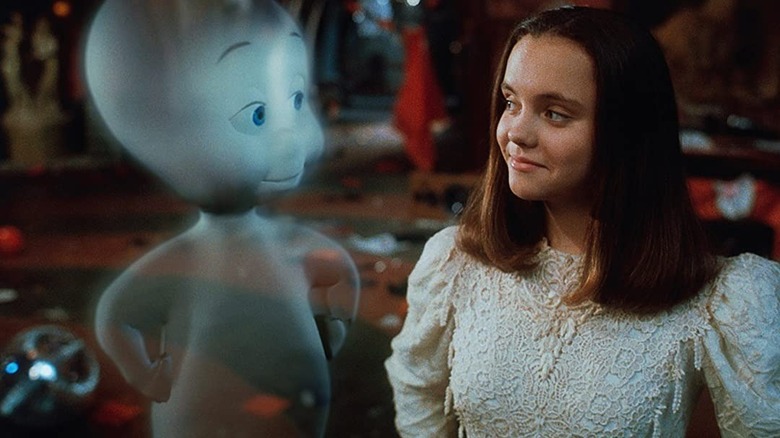
Perhaps one of the best transitional horror movies ever made, the family flick "Casper," is an all-time ghostly great.
Based on the popular Harvey comics series "Casper the Friendly Ghost," the 1995 supernatural, dark fantasy dramedy has a lot more going for it than most remember. Often remembered as a silly children's movie about a CGI ghost kid looking for a friend, "Casper" is a surprisingly powerful examination of neglect, grief, and our inability to process the finality of death. Paranormal therapist James Harvey (Bill Pullman) moves into the haunted Whipstaff manor with his daughter Kat (Christina Ricci), desperately trying to contact the spirit of his deceased wife. After initially being scared of the ghosts inhabiting the manor, Kat befriends Casper (voiced by Malachi Pearson), the son of an inventor who eventually drove himself into madness trying to bring him back from the dead.
There's a sinking sadness to "Casper" that is effortlessly offset by its moments of joy, allowing the problems in the Harvey family's life to hold equal weight to the desires of Casper and his trio of ghostly uncles also residing in the home. Death is not treated as a taboo subject too difficult for young viewers to understand but is also presented in a way that emphasizes the severity of pain that can occur after losing a loved one. Mourning is difficult and people process death in a variety of different ways, and few movies showcase this truth quite like this one. "Casper" is equal parts fun as it is frightening, making it an incredible way to introduce the themes of mortality to audiences of all ages. (BJ Colangelo)
The Haunting
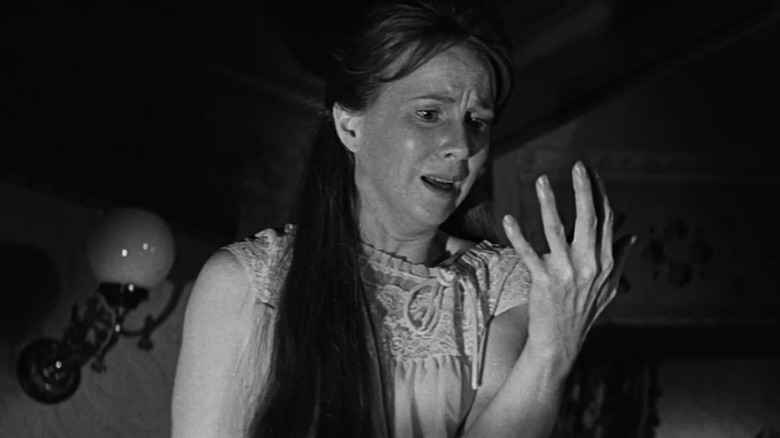
Long before Mike Flanagan terrified audiences with "The Haunting of Hill House," there was Robert Wise's 1963 adaptation of Shirley Jackson's novel, "The Haunting."
Robert Wise is truly one of the greatest directors to ever put moving pictures to celluloid, and "The Haunting" is an absolute masterclass in tension. Wise perfected the modern Gothic drama and did so without needing to rely on graphic, revolting imagery, or jarring editing techniques. Rather, Wise utilized the set design, cinematographic framing, lighting, split diopters, and an effective sound design to keep his audience keyed up. When we think of the expression "less is more," few films encapsulate the practice quite like this film.
There's something in this house, but the audience is never given the chance to see just what that something is. The power of "The Haunting" is its constant sense of creeping dread, and while the atmosphere is eerily restrained, it works in perfect juxtaposition against Julie Harris' performance as Eleanor. Harris delivers one of the all-time great horror movie performances as a woman constantly on edge, with a palpable sense of anxiety and genuine fear. When the frightening moments strike, it is Harris who helps raise the stakes, as her reactions are oftentimes more horrific than the actual hauntings.
Martin Scorsese has gone on record to declare "The Haunting" as the scariest horror movie he's ever seen, and it's hard to argue his point. "The Haunting" is a phenomenal work of art and without the film's success, the subgenre of ghost movies may not have been possible. (BJ Colangelo)
Ju-On: The Grudge
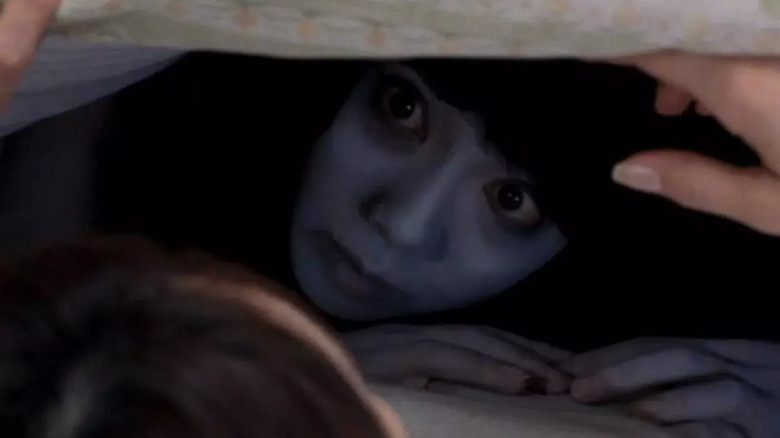
There was a huge boom in Japanese horror films around the turn of the 20th century as filmmakers like Takashi Miike and Hideo Nakata unleashed their terrifying tales on unsuspecting audiences. Many of these films were remade in America, including the 2002 classic "Ju-On: The Grudge," though they rarely held a candle to the originals. "Ju-On," written and directed by Takashi Shimizu, is a deeply disturbing ghost story that transcends cultures and never really needed a remake, even if Shimizu himself directed it."Ju-On" is technically the third movie in the franchise, though it's the first one to get a theatrical release. The first two films, "Ju-On: The Curse," and "Ju-On: The Curse 2," were only released on television in Japan, and thus "Ju-On: The Grudge" was the first part of the franchise to make it overseas. The movie follows a young woman named Rika, played by Megumi Okina, who works as a social worker and caretaker for the elderly. While she takes care of an old woman, she discovers a curse in the house and its not-so-friendly ghost inhabitants.A big part of the success of "Ju-On" was just how creepy its two ghosts managed to be. The young boy ghost, Toshio, and his murdered mother Kayako are two of the scariest spirits in horror history, and Kayako's unnerving staircase walk is unforgettable. "Ju-On" is a distinctly Japanese story that manages universal appeal, using traditional imagery and themes to tell a terrifying story anyone can relate to. While many ghost movies hesitate to reveal their creepiest cast members, "Ju-On: The Grudge" utilizes them to perfection. (Danielle Ryan)
Kwaidan
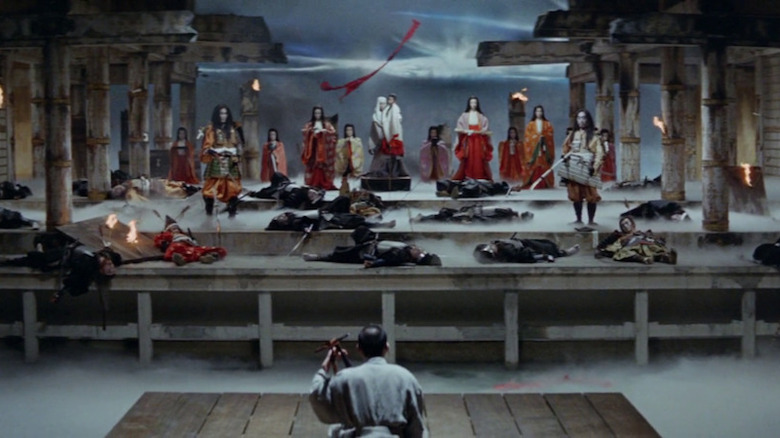
It's about time that a horror anthology made the list. "Kwaidan" is a 1964 four-part feature pulled from Lafcadio Hearn's retold collection of Japanese ghost tales. The segments, each rooted in a morality lesson, run from mournful to "Twilight Zone"-levels of surreal. The strongest segment in the assembly is "Hoichi the Earless," a sweeping story shot on elaborate theatrical sets showcasing this mythic, larger-than-life feel. In it, a young musician is summoned from his temple to perform an epic poem for a dead emperor and his court. Hoichi can't see the phantoms, but the viewer can, and the saga is delivered with plenty of time for ornate displays of life and death, at a three-hour runtime. The U.S. premiere saw the movie's wings clipped a little bit more, lopping off the entirety of the segment "The Woman of the Snow."
Potential spoiler: the plottings of the story's lady monster resemble those of the morbid "Lover's Vow" segment from John Harrison's 1980 anthology "Tales From the Darkside," culled from the same Hearn collection, "Kwaidan: Stories and Studies of Strange Things."
Don't come for scares, even though there are some unnerving parts; come for the polish on it. The sight of the samurai clan battle from the poem isn't going to be as violent as a horror fan might expect, and the film holds back from gruesomeness. In "Kwaidan," ghosts are accepted as real and part of everyday life instead of something to be debunked. They're both eerie and gorgeous, unnerving and magnetic. Every story swings like this, back and forth between the dead and the living, and the balance keeps going with a soundtrack from composer Toru Takemitsu, who gave an equally ambitious score to Akira Kurosawa's "Ran." The result is so immersive that walking away after the end of Kobayashi's "Kwaidan" feels like barely escaping with one's life, and living to tell the tale. (Anya Stanley)
Stir Of Echoes
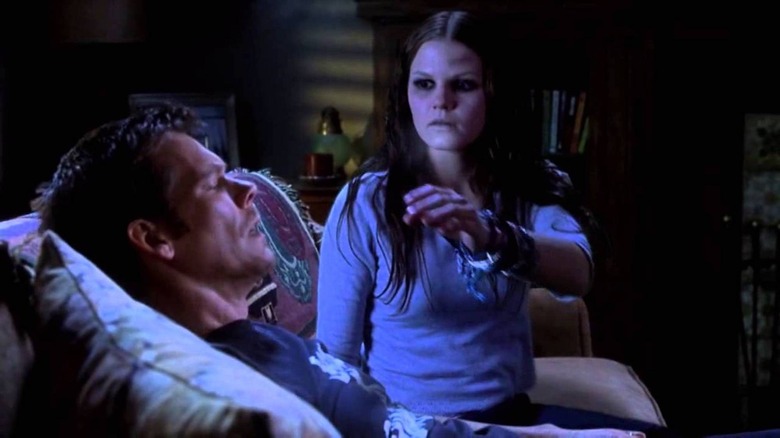
There were two great ghost movies in 1999, and one of them was David Koepp's "Stir of Echoes." It's an adaptation of Richard Matheson's 1958 novel about an average working-class guy named Tom who has a kind of second sight awakened within him, and how that sends his life into a tailspin.
The film stars Kevin Bacon as a cynic who gains the ability to communicate with the dead after being hypnotized. He goes from not believing in ghosts to seeing one in an instant. Not only can he see this off-putting apparition, but he can also see the circumstances of her death. As he begins to piece together exactly what happened to her, he gets closer and closer to a revelation that will not only put him and his family in danger but could very well tear his seemingly happy little neighborhood apart.
While it was a moderate hit, "Stir of Echoes" got drowned out by the monster success of "The Sixth Sense" which hit screens just one month prior to its release. This was a huge shame because Koepp's movie is skillfully made all around. The acting is top tier, the mystery is compelling, the scary stuff is legitimately disturbing, and it's all told in a tight one-hour and 39-minute story.
"Stir of Echoes" and "The Sixth Sense" complement each other really nicely: they're both tales about how ghosts aren't nearly as scary as the living and both have cute little kids that can speak with dead people.
While "Stir of Echoes" might never have the same impact on pop culture as its spooky 1999 twin, expect it to have a longer than average shelf life for a genre film. (Eric Vespe)
The Changeling
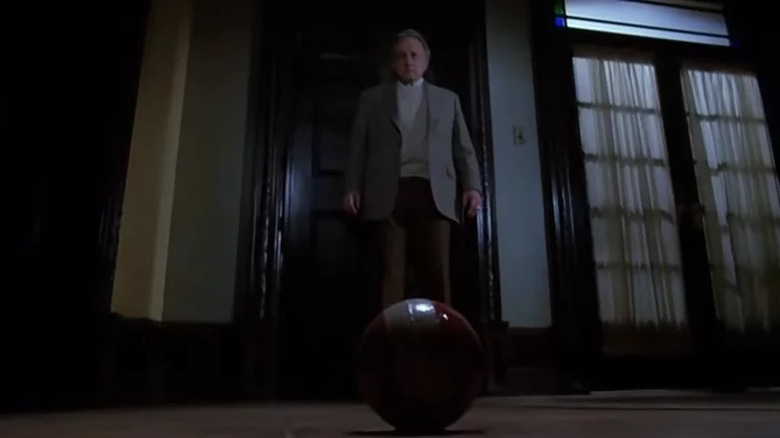
Horror cinema owes a great debt of gratitude to Peter Medak's "The Changeling." The truly iconic ghost story starring George C. Scott influenced some of cinema's greatest filmmakers including Martin Scorsese and Guillermo del Toro. "The Changeling" is the reason we have much of the "Conjuring" universe, moments from the "Insidious" franchise, and seems to have been a big influence on "The Ring." Not to mention the film's influence on "Poltergeist" and the fact that "The Others" literally would not exist without it.
After losing his wife and daughter in a tragic car accident, John Russell (Scott) moves from Manhattan to Seattle for a position teaching music composition at the local college. He rents an old Victorian mansion, the perfect place for him to live and work, except it seems he's not alone. A presence resides within its weary walls, the spirit of a little boy who was murdered by his father and replaced with a changeling. He wants something, but what is unclear, and only John can help.
Like some of the best titles on this list, "The Changeling" masters the elements of a memorable ghost story: humanity, grief, and loss. The film is a poignant meditation on the way we process grief and how that pain is part of the healing process. It weaponizes happy memories, turning keepsakes into nightmare fuel with the power to destroy you.
"The Changeling" is timeless, a haunting story about loss and grief that resonates with everyone, regardless of age. The older you get, the more horrifying and heartbreaking it becomes. It truly gets better with age. (Ariel Fisher)
Thirteen Ghosts
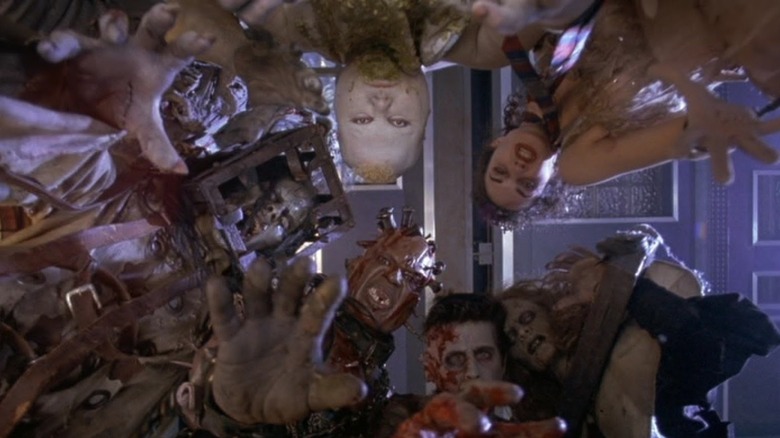
Following in the footsteps of the Dark Castle Remake of "The House on Haunted Hill," the adventurous "Thirteen Ghosts" (or "Thir13en Ghosts" according to the marketing) took Y2K-era horror sensibilities and combined them with a terrifying rogues' gallery of brilliant ghost characterizations.
Steve Beck's "Thirteen Ghosts" gave the William Castle story much-needed defibrillation, exchanging the funhouse aesthetic of slamming doors and throwing dishes for extreme violence and graphic deaths. The original film centered on an occultist who captured ghosts from around the world, and for the most part, "Thirteen Ghosts" follows a similar premise. However, it's the inclusion of the ghosts as part of the Black Zodiac that has given the film its staying power after all these years. Characters like The Angry Princess, The Juggernaut, and The Jackal became nightmare fuel for a generation, and continue to terrify audiences even today.
At the turn of the millennium, filmmakers were fascinated with the advances in technology and often incorporated these elements into their work. The house of the "Thirteen Ghosts" remake trades in the classic residential home of yesteryear for a high-tech glass home with inscriptions embossed on the walls. The new setting immediately adds an increased level of anxiety for the viewer, with the sliding, mechanical doors providing the constant threat that the inhabitants are never safe. At any moment, a malfunction could occur, unleashing the vengeful spirits to enact a reign of terror.
Horror from the aughts is often dismissed as a sea of slasher remakes in the wake of "Scream," but the 2000s delivered plenty of quality films, and "Thirteen Ghosts" is one of them. (BJ Colangelo)
The Devil's Backbone
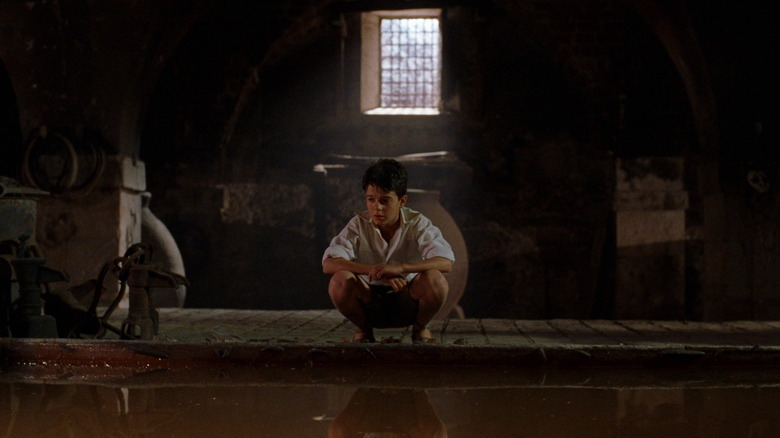
There's plenty of Gothic horror to be found on any list of the best ghost stories, but "The Devil's Backbone" stands head and shoulders above most. The Spanish-Mexican effort follows in the Guillermo del Toro spirit his work is known for, of allegory infused with the supernatural.
Set in 1939 in the midst of the Spanish Civil War, a young orphaned boy named Carlos (Fernando Tielve) struggles to fit in at a remote orphanage, where he's subjected to bullying and crime, and that's before the specter of a dead boy shows up. Instead of a haunted castle in this ghost story, the orphanage is the isolated setting — and it is isolated, even tomb-like. The danger becomes even more insistent with an unexploded bomb sitting in the courtyard, just another consequence of war for these kids.
Like many of his other films, some adults are safer than others, and certain humans are bigger threats than the spirits. While the ghost haunting the orphanage is good for creepy moments, the film is more obsessed with conceptual and generational specters, and the way that war irritates and complicates the healing process for everyone. "The Devil's Backbone" is anchored by a luminous cast that includes prolific Argentine actor and three-time del Toro collaborator Federico Luppi, also seen in "Cronos." Richly textured in warm sepia and icy blues and deliberately paced to give as much life to its characters as possible, "The Devil's Backbone" is both warm and icy, tender and distraught. (Anya Stanley)
Hausu
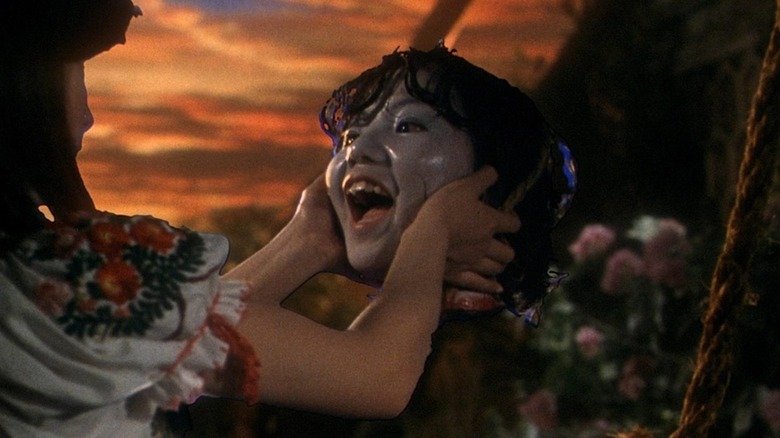
Ghost movies are typically associated with the familiar, dreary aesthetic of dusty old houses and spirits donning antique garb, but 1977's "Hausu" couldn't be more different. Known to English-speaking viewers as "House," Nobuhiko Obayashi's paranormal psychedelic masterpiece is an assaulting visual buffet of disembodied heads ready to bite a victim in the rear, random bursts of animation, a piano that chomps people into little pieces, dancing skeleton puppets, and a painting of cat with the ability to spit enough blood to drown an entire house.
After a young woman named "Gorgeous" invites her friends to her aunt's countryside manor, the group is terrorized by the colorful and outlandish haunts that await them. Obayashi wrote the film with influences from his young daughter, Chigumi Obayashi, not unlike how Robert Rodriguez wrote "The Adventures of Sharkboy and Lavagirl." The result was a disturbingly imaginative ghost story that leaned into frenetic and camp aesthetics, reveled in less-than-stellar special effects, and threw audiences into a fever dream that only a small child could have concocted. The bizarre presentation feels like a precursor to horror greats like Sam Raimi and Peter Jackson, playfully incorporating absurdist humor against the backdrop of graphic horror.
Ghost movies don't often get the chance to have fun, but "Hausu" is as hilarious as it is effectively creepy. Despite the constant barrage of disturbing (albeit silly) imagery, there's something whimsical about "Hausu" that entices audiences and makes it difficult to look away. "Hausu" continues to be hailed as one of the best Japanese horror films ever made, and truly showcases the potential of ghost movies if creatives are willing to take a wild swing. (BJ Colangelo)
The Frighteners
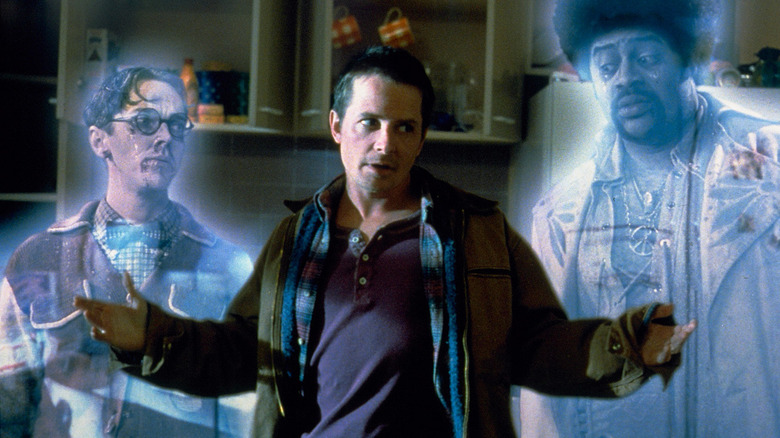
Before he made "The Lord of the Rings," director Peter Jackson made a handful of horror movies, including the horrifying and hilarious "The Frighteners" in 1996.
"The Frighteners" stars Michael J. Fox as Frank Bannister, an architect whose wife dies in a tragic accident that also leaves him with the ability to see and talk to ghosts. Instead of dealing with his trauma and grief and continuing his life, Frank becomes a con man, befriending a trio of ghosts played by Jim Fyfe, Chi McBride, and John Astin. The ghosts help him haunt the town, and he charges unsuspecting homeowners to "exorcise" the spirits. The real problem starts when a demon starts haunting the town for real, and Frank is the only one who could possibly stop him."The Frighteners" is a horror-comedy that leans harder into being funny than scary, but Jackson's ability to frighten is still on full display. It's rated R for violence and terror and isn't the kind of fluffy, family-friendly fare you'd expect from his later films or Fox's usual oeuvre. Fox also plays against type a bit, portraying a character that's likable enough but does a lot of scummy things. He's a far cry from Marty McFly, but he's still hilarious and charming in a much more adult way.What's so fascinating about "The Frighteners" is that it manages to balance gross-out humor and intense violence with a warm, gooey center that's as much marshmallow fluff as it is blood and guts. This is a unique horror-comedy directed by one of the genre's best, and its ghostly characters are some of the most "fleshed out" in all of cinema. (Danielle Ryan)
The Others
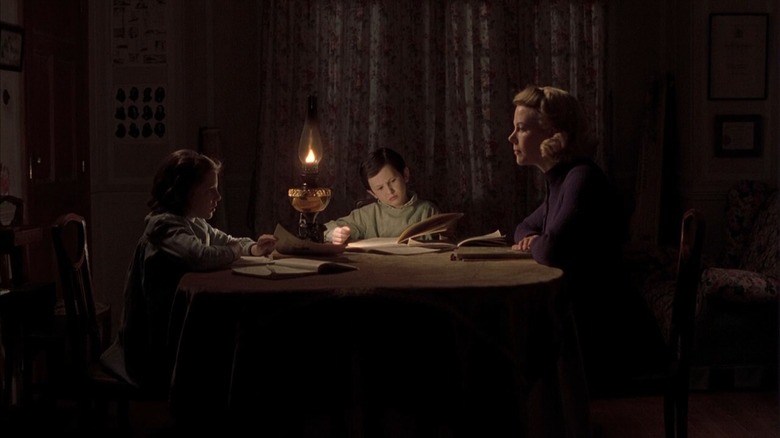
Alejandro Amenábar's 2001 thriller "The Others" is impressively frightening given its simplicity. This Hitchcockian tale follows a woman named Grace, played perfectly by Nicole Kidman, who lives with her two children in a mansion in Bailiwick of Jersey while she waits for her husband to return from World War II. The children are photosensitive, meaning that they cannot be in direct sunlight or it will hurt them, and so Grace enacts strict rules to allegedly keep them safe. When she hires a group of servants to help her care for the house and her children, the carefully crafted environment begins to crumble, and the family's true horrors are revealed."The Others" is an unconventional ghost story with all of the usual set pieces: creepy kids, a sprawling mansion, and mildly terrified visitors. It's a slow burn that builds gradual dread instead of relying on jump scares or scary imagery, playing a psychological game with both its characters and the viewer. Kidman's performance is the glue that holds everything together, giving it her all and delivering a complex character. Having children is like having a piece of your heart outside of your body, and having children with such debilitating conditions must be absolutely terrifying. As much as audiences fear the ghosts the children talk about, they also fear for the children's safety from the outside world and the thing that usually helps humans thrive: the sun.With "The Others," the less you know, the better. It's a smartly subversive thriller that flips some tropes on their heads while leaning into others, held together by excellent performances and even better cinematography. It's also not terribly violent, so this PG-13 horror can be shared with some younger viewers. (Danielle Ryan)
The Sixth Sense
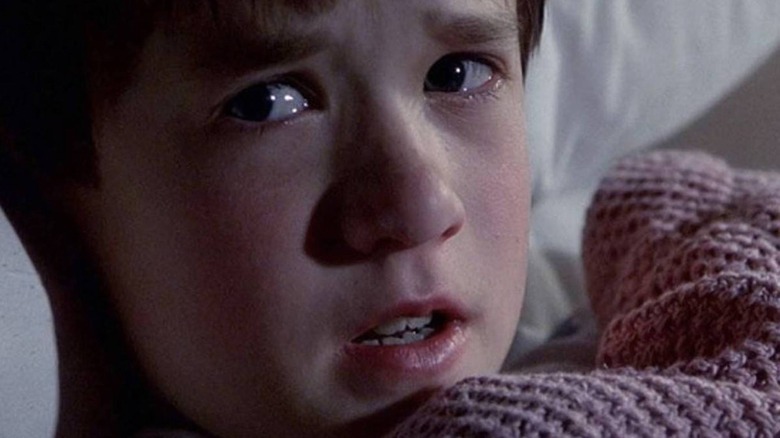
"The Sixth Sense" is not only one of the best genre movies ever made, but it is also one of the highest-grossing ghost stories of all time, coming in at $672.8 million in box office receipts. The "Pirates of the Caribbean" movies and "Coco" rank higher on the all-time box office and are obviously ghost stories, but not ones focused on frights. In fact, the only flat-out horror movie that has outgrossed "The Sixth Sense" is 2017's "It."
"The Sixth Sense" was such a cultural phenomenon that it has been the go-to example of a twist ending for over 20 years. The reason the movie has lived on in the hearts and minds of film fans the world over, however, is that the twist is only the cherry on top. The real staying power of "The Sixth Sense" is on the shoulders of writer/director M. Night Shyamalan and stars Haley Joel Osment, Bruce Willis, and Toni Collette.
This story of a little boy cursed with the ability to see dead people and the lost psychiatrist who sees him as a way to make up for failing a previous patient is immaculately written, performed, and shot. Shyamalan takes his time, really setting the stage to get to know and love these characters before we start seeing the horrific images this poor kid is faced with on a daily basis.
Yes, the twist is all-timer stuff. It's perfectly set up and the revelation is a gut punch on an emotional level, but the story isn't about the trick and that's why people still hold it up as one of the best genre movies in recent memory. (Eric Vespe)
A Tale Of Two Sisters
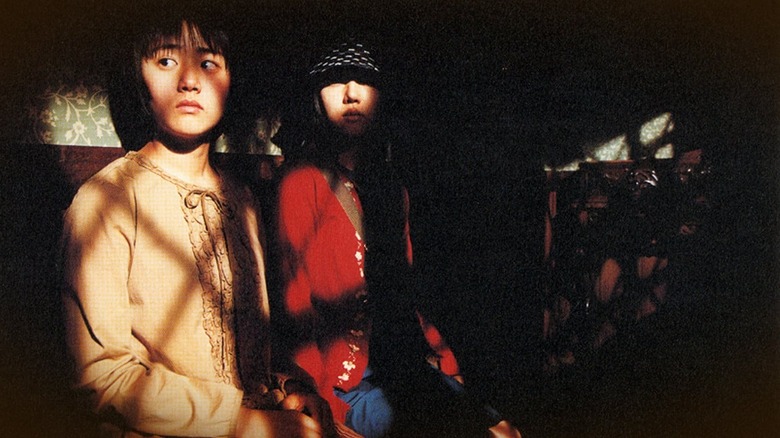
Since so many ghost stories blur the boundaries between the internal and the external, many of the best ones are devastating tiptoes toward the edge of someone's unstable psyche. "A Tale of Two Sisters" is one such masterpiece where the hauntings are coming from inside the house on a psychological level as well as a physical one.
Kim Jee-woon's modern folktale is adapted from a classic one — in which two young sisters are killed by their vicious stepmother — hailing from Korea's Joseon Dynasty and getting about as many adaptations as Charles Perrault's "Bluebeard" tale. The story follows a young woman, eldest daughter Su–mi (Im Soo-jung), fresh out of a mental institution. Su-mi struggles with herself and the cryptic question asked at the beginning, "Who do you think you are?" She goes back to her confined childhood home along with her sister where disquieting events unfold that seem tied to their judgmental stepmother, Eun–joo (Yum Jung-ah), and a grim, mysterious family past, while Su-Mi's distant father, Moo–hyeon (Kim Kap-soo), hints that something is off about the family dynamic.
It unravels alongside Lee Byung-woo's masterful score; the epilogue music conjures up a swell of emotions as conflicted as its story. But the conflict is on purpose, because "A Tale of Two Sisters" is a ghost story about perspective, and about the triage of reality that deploys in people's memories. The movie hits hard not with ghostly moans, but with the heartfelt wails and dread-filled silence of a Shakespearean tragedy where the human mind rebels more than a creaky house, and everyone is punished for their past decisions, with hellish consequences. (Anya Stanley)
Lake Mungo
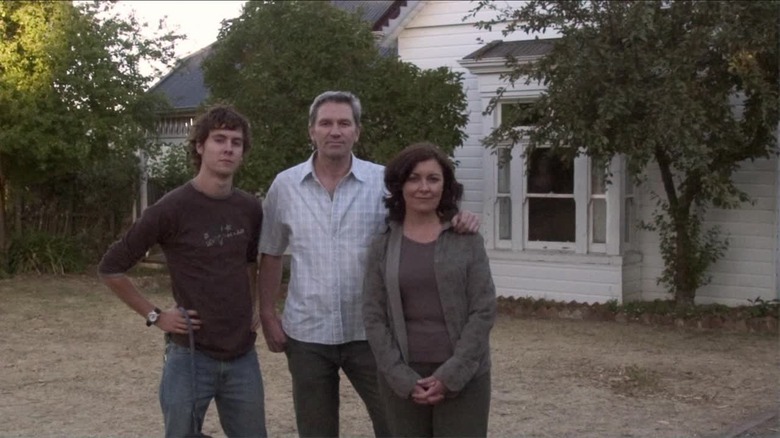
Joel Anderson's devastating 2008 Australian psychological horror film "Lake Mungo" came along at a wild time for the found footage subgenre. It was the same year that shaky-cam scares chronicled a kaiju attack in "Cloverfield" and an L.A. apartment under government lockdown in "Quarantine," itself a remake of the 2007 Spanish film "REC." Only the year before, Oren Peli's "Paranormal Activity" screened at Screamfest Horror Film Festival, starting the journey towards Jason Blum and a megahit wide release that made a found-footage movie one of the most profitable horror movies ever. What makes "Lake Mungo'' different is its marriage of found footage and mockumentary approaches used to tell what appears to be a ghost story.
The story chronicles a family's search for answers in the wake of sixteen-year-old Alice Palmer's (Talia Zucker) drowning death. When her brother Mathew (Martin Sharpe) captures images that look vaguely like Alice on and around the family's property, the narrative takes several ghastly, soul-crushing turns. Not much more can be said without spoiling the movie, but its scare power lies not in jumps and shocks, but in imagery that lies in plain sight, priming the pump for similar dread-filled revelatory scares in Ari Aster's "Hereditary" and Andy Mitton's "The Witch in the Window." Presented docu-fiction style, the movie hits like something lurid found on tv during the insomniac witching hours. Not only does the footage manipulate, but Anderson includes sly judgment on the viewer who falls for it, all while keeping grief and bereavement due north throughout the story.
"Lake Mungo" is not a movie to put on in the background; for the brave and bold movie watchers unafraid to lean into the screen, this is a lights-out, sound-up kind of experience. (Anya Stanley)
Poltergeist
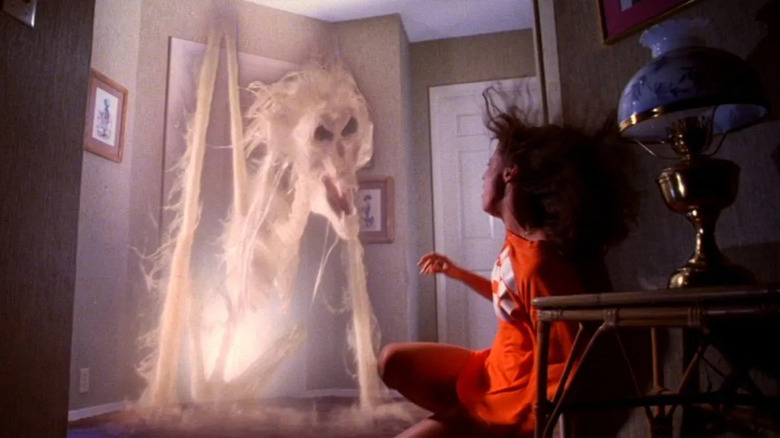
"Poltergeist" scarred a whole generation who will never trust static on TVs or creepy clown dolls as long as they live. It also happened to modernize the ghost story in a whole new way.
Horror in the 1970s and 1980s was all about bringing the monsters of yore into a recognizable world, away from gothic castles and foggy European graveyards. Tobe Hooper did that with "The Texas Chain Saw Massacre," bringing his iconic killer into recognizable small-town Texas, and Steven Spielberg delivered a believable great white shark to the shores of a small coastal town in "Jaws." It was only fitting that the two would team up to completely redefine how audiences saw ghosts on film in "Poltergeist."Spielberg wrote the script himself, his first screenplay credit since "Close Encounters of the Third Kind," which tells the story of the Freelings who could be the family up the block. Ghosts in suburbia were not a common thing at this point, which makes their appearance here all the more shocking."Poltergeist" doesn't pull any punches. Kids are constantly in danger, when the ghosts show up they're far more terrifying than just spectral shapes or people in ratty clothes and white pancake makeup, and all that tension is only heightened because you care about this family. It could be your own! One day you might wake up to find the old backyard tree trying to eat your kid!With a wonderful Jerry Goldsmith score, beautiful cinematography, fantastic performances, and ILM at their best, "Poltergeist" remains a classic. (Eric Vespe)
Read this next: The Horror Movies We Can't Wait To See In 2022
The post The 15 Best Ghost Movies Of All Time, Ranked appeared first on /Film.
Resident Evil 2 PC upgrade patch will raise minimum required specs
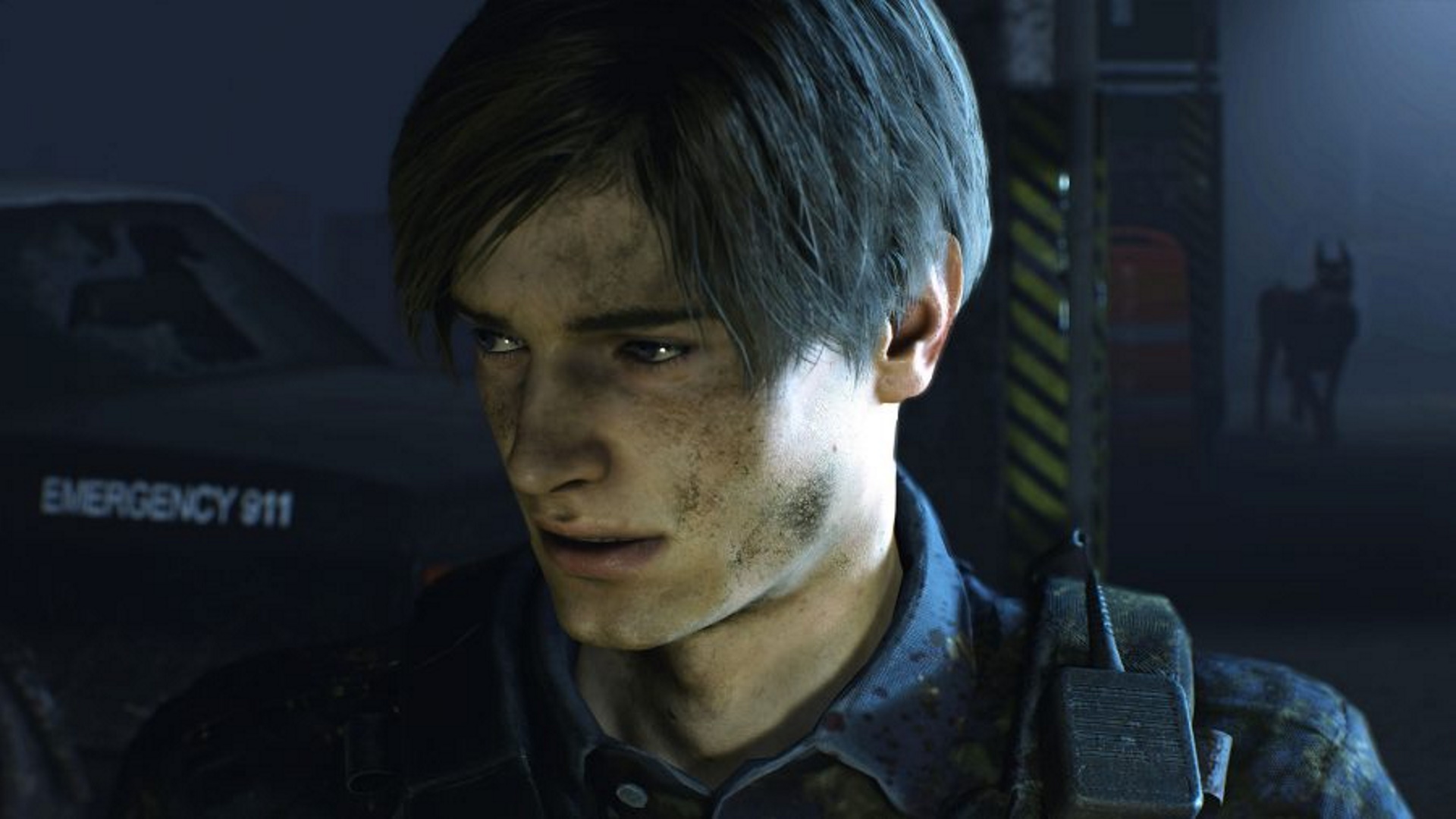
The Resident Evil 2 PC upgrade will bring it, along with Resident Evil 3 and Resident Evil 7, in line with current-gen consoles by adding ray tracing and other enhancements – but it’s also changing the system requirements. After the patch goes live, the survival horror game will no longer support DirectX 11 drivers and will only be playable on DirectX 12, Capcom said in a short update on Steam.
It will tweak a few other system requirements as well. The minimum specifications will no longer include Windows 7 and 8.1 (64 bit). You’ll need Windows 10 (64 bit) or Windows 11. Resident Evil 2 currently supports Nvidia GeForce GTX 760 and AMD Radeon R7 260x, but after the update, you need at least GeForce GTX 960 or AMD Radeon RX 460.
Capcom gave no indication when it expects the update to go live, but some eagle-eyed internet users have already spotted the franchise’s updates on Sony’s servers. It's caused a bit of speculation that they may arrive sometime after the publisher's June 13 summer showcase.
RELATED LINKS: Resident Evil 2 review, Resident Evil 2 system requirements, Resident Evil 2 TyrantDon’t miss Metal Max Xeno Reborn now that it’s on PC, PS4, and Switch

Not your everyday JRPG
[This week Destructoid is brought to you by Metal Max Xeno Reborn, out now for Nintendo Switch, PlayStation 4, and PC (via Steam). This is a sponsored post.]
The long-awaited Western release of Metal Max Xeno Reborn is finally here on Nintendo Switch, PS4, and PC, and Pochi the cannon-packing pooch is calling your name.
Not only can you "pet the dog" in this post-apocalyptic open-world JRPG from Kadokawa Games, he's actually an active part of the squad! Some might even say Pochi is the MVP. Together, you'll face ferocious oddball threats like dinosaur battleships, massive sand sharks, and missile-armed rhinos. This isn't your average JRPG tank adventure, that's for sure.
Metal Max Xeno Reborn is one of many RPGs in the lovably outlandish Metal Max series, which dates all the way back to the early '90s on Famicom. If you're looking for an easy entry point, Reborn is definitely it — it's a new-and-improved remake of 2018's Metal Max Xeno for PS4 and PlayStation Vita. In an ongoing war against the supercomputer NOA, you'll join the fray as Talis.
While exploring the wastes of Tokyo Bay on foot and in a fleet of heavy-duty vehicles, Talis will band together with fellow survivors to fend off machines and save what's left of humankind.

Real-time vehicular action in the post-apocalypse
Best of all, the skirmishes in Metal Max Xeno Reborn take place on the open-world map, so you can choose your moment to strike and even gain the upper hand from afar. The game's dynamic combat system blends fast-paced real-time movement with turn-based JRPG sensibilities.
As your party gains experience points and scavenges for parts, you'll learn new combat techniques and have more heavily-armored toys to play with — customization is the name of the game here. Just don't forget to feed Pochi some snacks while you're out there grinding!
To take down the big boss monsters of Metal Max Xeno Reborn, you'll need to exploit weaknesses to burn, freeze, and beam, among other elements. And when you're picking out the ideal engine and weapons for your dream tank loadout, you'll also want to consider special trait chips — they offer powerful bonuses like a multi-shot and increased critical chance. Who doesn't love to land crits?
https://www.youtube.com/watch?v=VnLA0Yo4eaI
As the launch trailer shows, this game's cult-classic vibes are front and center. If you're looking for something different in the JRPG crowd that you can sink your teeth into, Metal Max Xeno Reborn could be your new jam. Don't sweat it too much, but humanity is counting on you here.
You can cozy up with your monster-hunting, machine-blasting, apocalypse-canceling crew starting today. Metal Max Xeno Reborn is now available on Nintendo Switch, PS4, and Steam.
The post Don’t miss Metal Max Xeno Reborn now that it’s on PC, PS4, and Switch appeared first on Destructoid.
Starfield - Bethesda's High Expectations

Bethesda's upcoming sci-fi RPG Starfiled was delayed last month. But with this year's decentralized E3 now upon us, GamesRadar+ brings us a couple of quotes from Bethesda Game Studios' game director and executive producer Todd Howard and Microsoft Gaming CEO Phil Spencer that touch on their high expectations for the game. We're also told that at this point Starfield is mostly complete, and the delay shouldn't be a lengthy one.
Here's a quick excerpt:
"Starfield for me is a unique opportunity. Todd Howard has been a friend for an awful long time, and the fact that Bethesda Game Studios is working on a new IP, which has been a long time [coming]... This will be a hallmark for us – in terms of the acquisition of ZeniMax, getting to work with Todd, and bringing this game to market."
"I've seen a lot of this game, people are going to see more of it, and I love setting the goal of: Let's get more players for this game than in any other game."
Diablo: Immortal Reviews

Now that Diablo: Immortal is available on PC and both Android and iOS mobile devices, you might be interested in checking out some reviews for this free to play action-RPG spin-off. If that's the case, you can find a few of those below:
IGN In Progress:
I’ve only just started on my Diablo Immortal journey, but I like what I’ve played so far. The combat feels potent and weighty, with plenty of skill options for building out rounded and fun combat approaches. The story moves along at a brisk pace, opening up new zones steadily, while the many character progression systems ensured that I felt like I was always making progress and growing more powerful. And with more than 20 hours of microtransaction-free gameplay behind me, there’s clearly a lot of content to enjoy before you need to consider spending money, so this is very much a game you can try before you buy. Of course, it’s too early to say whether that’s too good to be true for the endgame as well, which is why I’m not yet comfortable slapping down a provisional score here. That kind of thing can cast a dark pall over even a great game. Stay tuned for my full review in the coming weeks after launch on June 2.
Destructoid 6/10:
I want to make this clear: without microtransactions in play at all, Diablo Immortal is actually a fun little multiplayer-centric take on the formula, especially on its native mobile home. At the end of the day, it’s free. Boot it up, finish the critical path, get to 60, and see how it grabs you. I don’t think it’s going to win over anyone who is disenfranchised by the series, but for folks looking for a dungeon crawling diversion, it definitely serves its purpose: and has room to grow. Hopefully that growth involves less microtransactions.
The team has a lot to be proud of from a technical and aesthetic standpoint, but the Lord of Live Service ultimately won the war.
NME 4/5:
Diablo Immortal is a ton of fun. A five minute session can soon turn into an hour or more, with constant gratification keeping you hooked for a number of hours. The end game may turn prohibitively expensive for the perfectionist player but for everyone else, simply enjoy the experience in the meantime.
PCMag 4/5:
Diablo Immortal will suck you deep into the Diablo loot loop that has kept people addicted for decades, only now on a device you carry with you at all times. The pacing may test your patience if you're not willing to pay up, but the game excels as daily, bite-size, action-packed chunks of devilishly delightful dungeon-crawling mayhem. In short, Diablo Immortal is a lavishly produced, fine little slice of hell.
Tom's Guide 3/5:
I don’t hate Diablo Immortal, although I imagine some gamers will. It’s a fairly inconsequential title in a storied series, and the F2P mechanics are as intrusive as they look. But if (and this is a big “if”) you can get past that, there’s a rock solid game underneath, with satisfying gameplay and plenty of different activities to pursue.
But Why Tho? 5/10:
For most of my time with Diablo Immortal, I was pleasantly surprised. But when I reached the endgame content it became clear that all of that was to trap me in an exploitative revenue scheme. I would have been more than willing to buy a battle pass here and there or even some cosmetics or expansions to support Diablo Immortal into the future, but its bold and scummy approach to manipulating vulnerable players not only soured my entire experience with the game but marks a dangerous cornerstone in the monetization of similar products in the future.
Dexerto 5/10:
Trust me when I say I really want to love Diablo Immortal more than this, but morally I struggle to recommend this game. Suffocated by microtransactions that bleed players dry, the latest chapter in the Diablo saga feels like a pay-to-win gacha game that’s meant to tide us over until Diablo 4.
While longtime fans of the franchise will be lured in by the story and spectacular universe, the cost of saving Sanctuary is simply too much to pay (as we’re sure your accountant will confirm).
I walk away from Immortal disappointed and angry, hoping and praying to the High Heavens that Blizzard do something to bring it back from the brink.





